(v12.13.14)
Art, Architecture and Design in Columbus, Indiana
This article spotlights a particular building or some other aspect of Columbus design. I welcome your comments, corrections and additions. Please share your experience and perceptions of these uniquely Columbus projects.
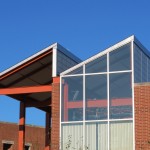 Mt. Healthy Elementary School
Mt. Healthy Elementary School
- Built: 1972
- Address: 12150 South State Road 58
- Architects: Hardy Holzman Pfeiffer Associates (NYC)
- Principal Design Architect: Hugh Hardy
- Project Architect: Michael Kaplan
- Assocated Architects: David B Hill and Associates
- General Contractor: A.E. Pitcher Construction Company (Greenwood, Indiana)
- 2002 Addition: Principal Design Architect: Nolan G. Bingham (Paris Bingham Partnership – Columbus, Indiana)
Mt. Healthy Elementary is one of our “country schools”. Although located along Indiana State Road 58 between Ogilville and Waymansville, it is a route seldom traveled by anyone but the residents of this southwestern area of Bartholomew County. As a result it is one of our notable landmarks seldom seen by visitors or residents alike. Mt. Healthy was the first rural Bartholomew County School built under the Cummins Foundation architectural program. Despite its obscure location it’s a very interesting building designed by Hardy Holzman Pfieffer Associates (HHPA) and is one of the far flung outposts on our “official” architectural driving tour. Mt. Healthy School took its name from a former school in the area which in turn was named for an early settlement which no longer survives as a town.
HHPA designed the school which opened 1972 as a symbolic return to the idea of the old one-room schoolhouse where all the students of different levels would be learning in the same open space. It ushered in an era of open-concept school buildings in Columbus meant to be flexible and conducive to new ideas in learning. The lack of walls and traditional classrooms ultimately became too distracting and many schools reverted to more traditional methods of teaching. Our local school system, the Bartholomew Consolidated School System (BCSC), has never been afraid to tackle new innovations and techniques in teaching as well as building concepts. They have also been flexible enough to change directions when the new ideas didn’t quit fit with our community. That innovation continues with several local schools now configured as “Signature Academies” and “New Tech Schools.”
HHPA’s design for the 50,000 square foot low lying school set on a 16 acre rural site south of Columbus used a number of dissimilar building materials set in geometric juxtaposition, creating a wide range of teaching environments. The school is compact with no traditional corridors resulting in a maximum amount of usable education space to gross building area. There are few completely isolated enclosures and a minimum of doors. There were no traditional doorways except at the passageways leading into the gymnasium and music room. The open concept school was divided into three distinct areas or “clusters”: The Primary cluster for grades K thru 2nd, the Upper Primary cluster for 3rd and 4th and the Intermediate cluster for 5th and 6th grades. The clusters were designed to function like an old fashioned one-room school with the large open areas permitting group learning in large and small groups as well as individualized work. Each cluster is an open, multi-level unit with easy access between levels as well as to the rest of the building. Dumbwaiters are installed to move teaching material and supplies between levels. An open access “spine” connects the clusters and leads to the cafeteria, gymnasium, IMC (library) and other shared areas. The carpeted multi-purpose cafeteria also allows for large group instruction. The gymnasium serves as well as a multipurpose room. The building plan was designed to be very flexible and adaptable due to its openness and the variety of enclosures. The original configuration was planned for an eventual 660 student capacity with space reserved on its west side for possible future expansion. The building was meant to be explicitly functional like the neighboring farm buildings and included a minimal landscaping plan.
For its time period, the building was a very cutting edge design with its open-concept plan enhanced by the exposed and brightly colored mechanical, structural and electrical elements. The support girders are orange, heating ducts are green and the exposed plumbing pipes are yellow. Its offset pattern of roof and wall glazing (windows) assure that no two clusters have exactly the same enclosure. The intermediate cluster was the only area with large expanses of glass, two stories high with skylight-like projections and many small panes. There are 4 long paired rows of clerestory windows used as skylights placed on a diagonal with the walls. The building is built of “profile face” concrete blocks faced with a special red Norman brick. Some of the exterior walls are covered by an industrial metallic material. From overhead, the building resembles a triangle with glass stairstep projections on one side. It is only on this side that large projections of paned glass windows are found, the other 2 sides have small irregularly placed windows decorated with rough cut Bedford limestone lintels and sills. Each “cluster” is marked on the interior by “supergraphics” A, B and C.
The “spine” of the building is a brightly colored corridor with patterned carpeting connecting all areas of the building. The three teaching clusters branch off from the spine. Despite the lack of traditional classroom walls there is abundant display space using stairways and the few odd wall spaces covered with beige burlap used to display student art work. A semi-circular stairway adjacent to the kindergarten area creates a natural performance area.
As the school was nearing completion, a teaching plan for the school was being developed in conjunction with Indiana University. The concept for the new curriculum centered on “team teaching and continuous progress”. The plan called for a “multi-unit” organization with students, teachers and teaching assistants divided into groups to fit the buildings cluster plan. Within each cluster, students can be grouped in different ways to meet their needs, interests and objectives. Teachers work as teams with one instructor being the unit leader of each cluster. The original concept of the school was intended to be non-graded with each student progressing at their own level but still meeting certain requirements.
The building was officially dedicated on Nov 19th, 1972. At the dedication, architect Hugh Hardy said, “The building was planned to reflect the future, which is actually a combination of the present and the past, with the best parts of both.”
In 2002, a 12,400 square foot addition to the school, designed by local architect Nolan Bingham of the Paris Bingham Partnership, was completed along the State Road 58 side of the building. Some remodeling was done to existing space with the addition of new administrative offices, meeting rooms and an enlarged gymnasium/school gathering space. A new primary entry on this side of the building along with a new parking area provided improved access and vehicular circulation through the site.
The school board insisted upon a “seamless” addition, meaning that the new structure should match as closely as possible to the character of the original building. They also wanted the entry points to be better defined for visitors with a separation between the entries for the younger and older students for safety reasons.
Similar materials and forms were used in perhaps a slightly more restrained fashion than the wildly imaginative design of Hardy Holzman Pfieffer. Even in a “seamless” addition, architects will seldom attempt to exactly duplicate an existing building out of respect to the original design. An addition is meant to be complementary and compatible with the original allowing older buildings to continue to be of service. Tan brick similar to the original building was used at the entryway to provide definition of that space. In the addition the tan brick used in the addition defined the lower level while in the original design it defined the second level of the building. Metallic panels used in the addition had an dark aluminum finish while they were white in the original. The addition won an award from the Indiana Concrete Masonry Association in 2003.
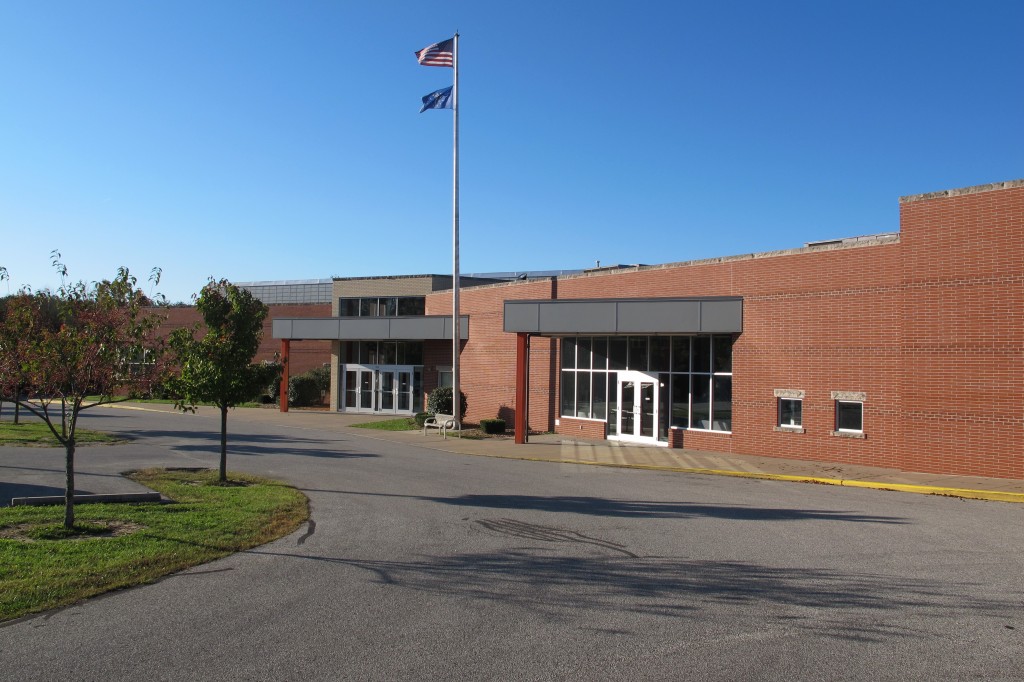
Entrance side (part of the 2002 addition)
(photo by Ricky Berkey)
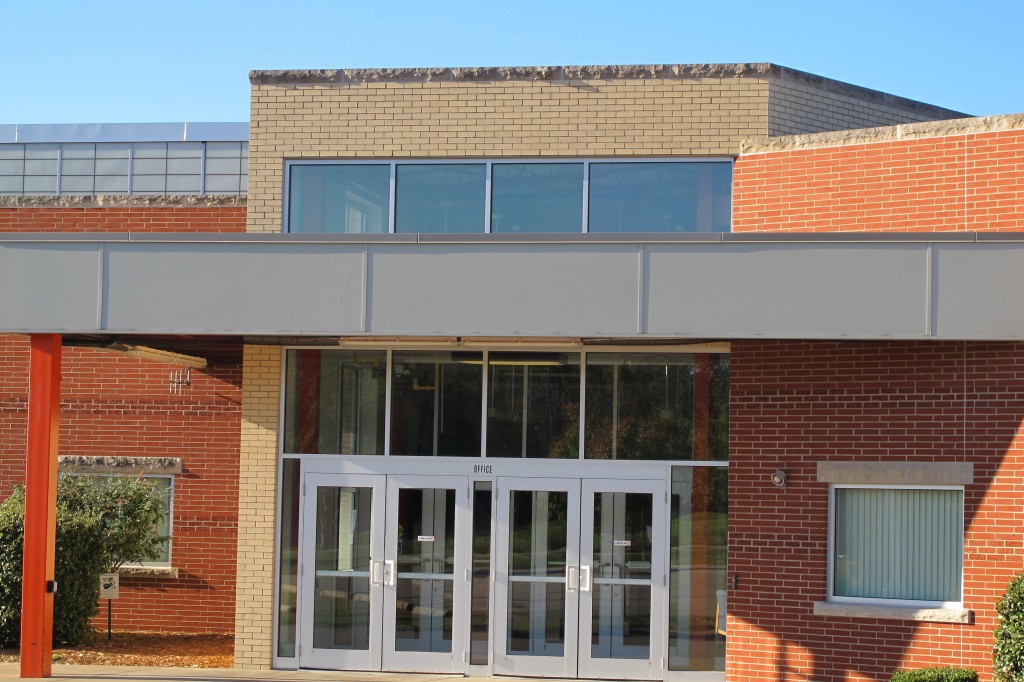
Main entrance (part of the 2002 addition)
(photo by Ricky Berkey)
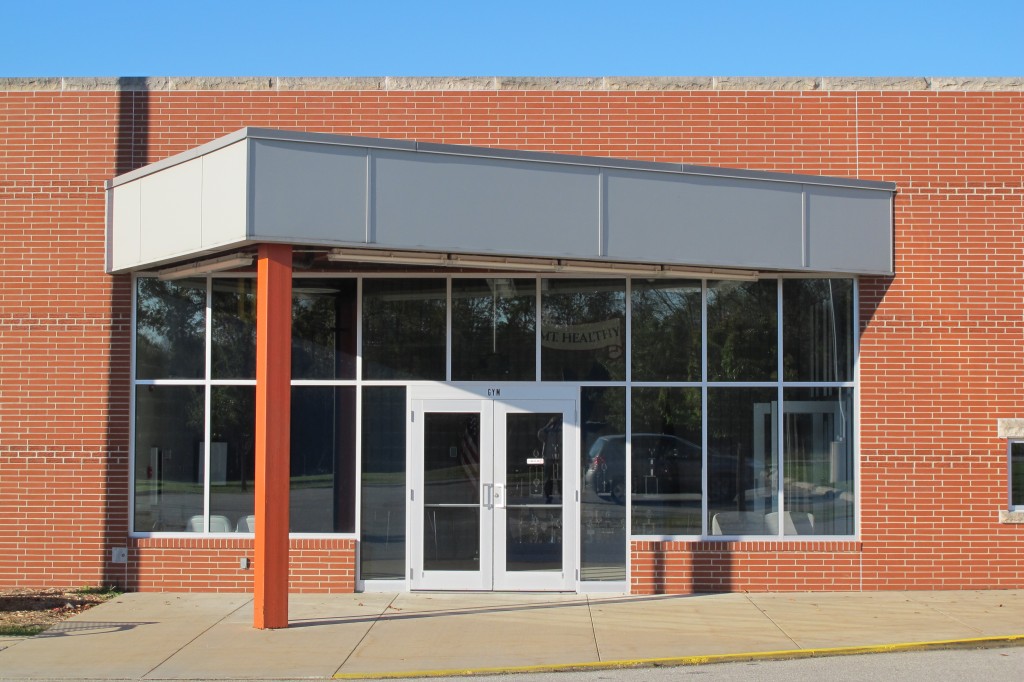
Gymnasium entrance (part of the 2002 addition)
(photo by Ricky Berkey)
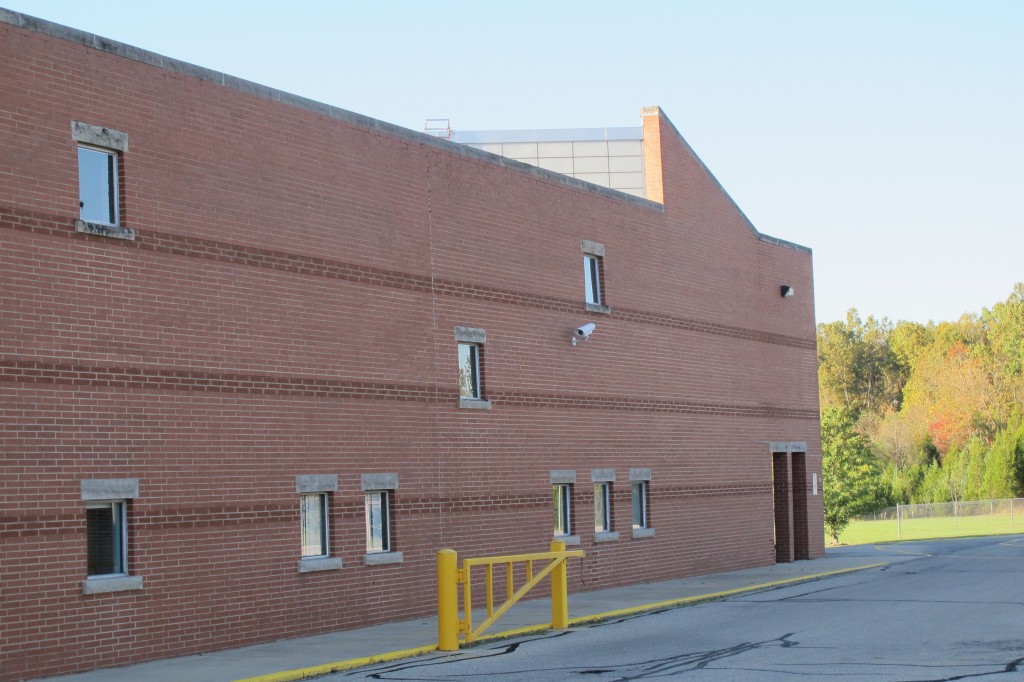
Right side of building, windows irregularly spaced with limestone sills and lintels
(photo by Ricky Berkey)
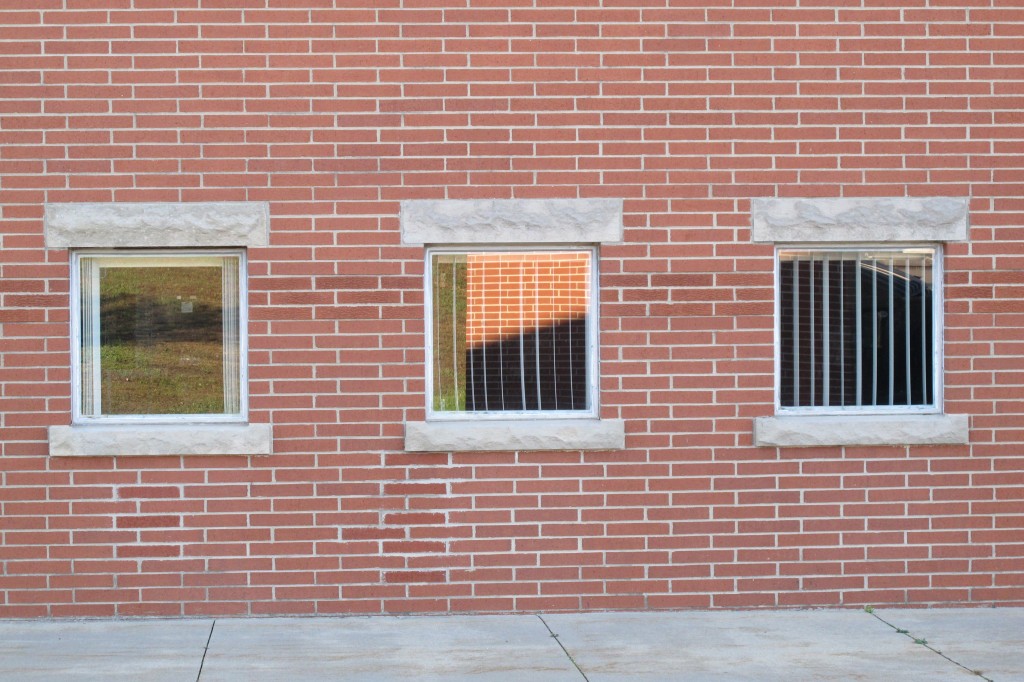
Closeup of right side windows
(photo by Ricky Berkey)
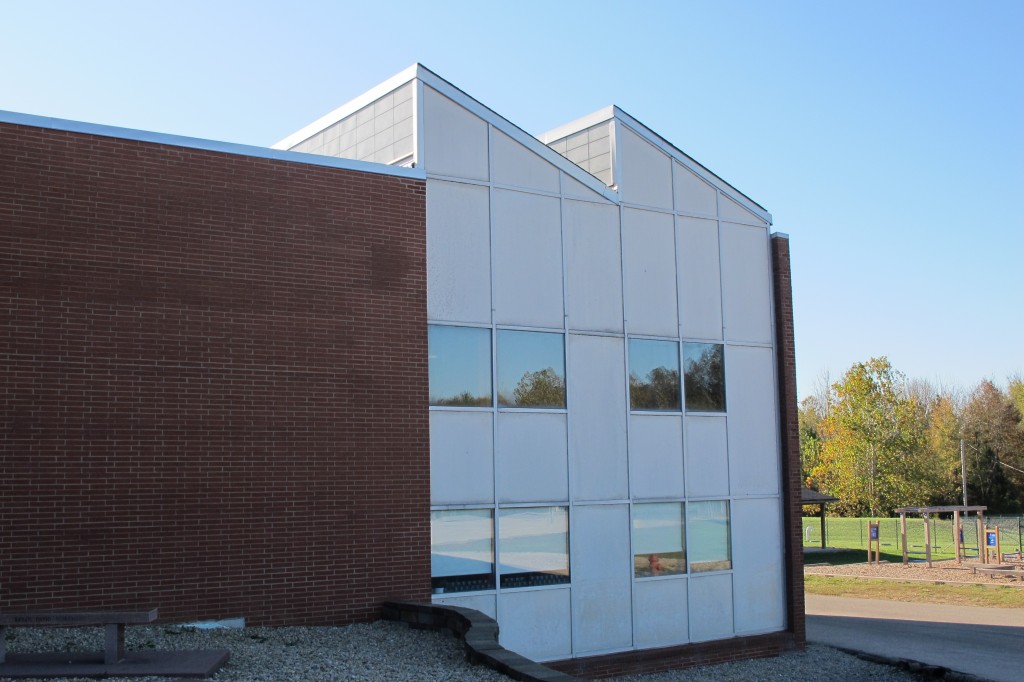
Rear side of building from the right showing clerestory windows
(photo by Ricky Berkey)
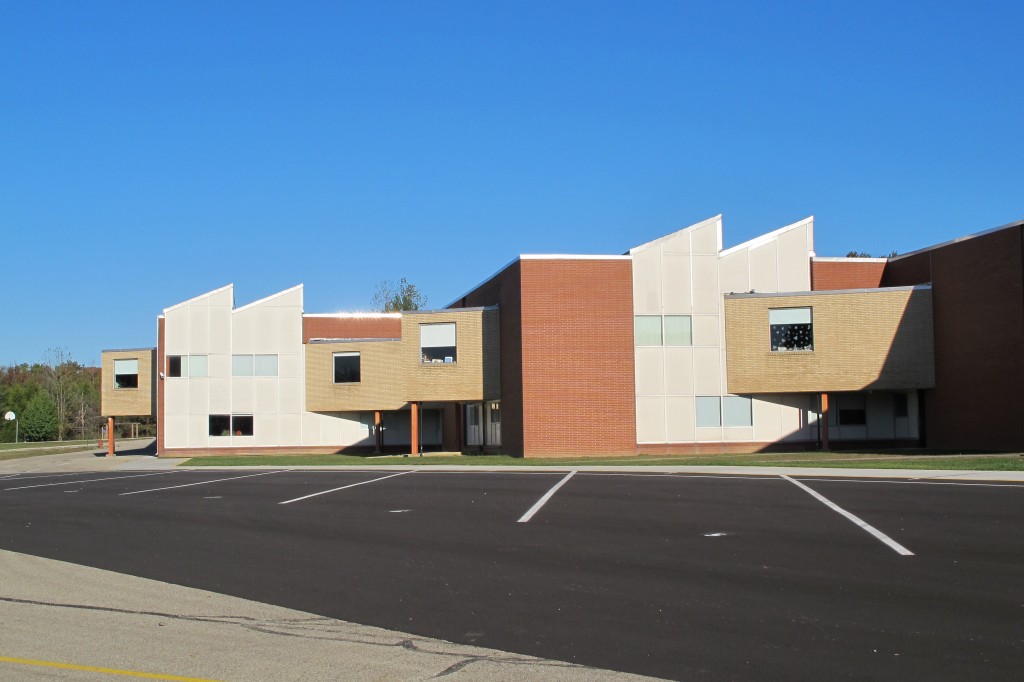
Rear of building from the left, interesting juxtaposition of materials and geometries
(photo by Ricky Berkey)

Rear of building from the left
(photo by Ricky Berkey)
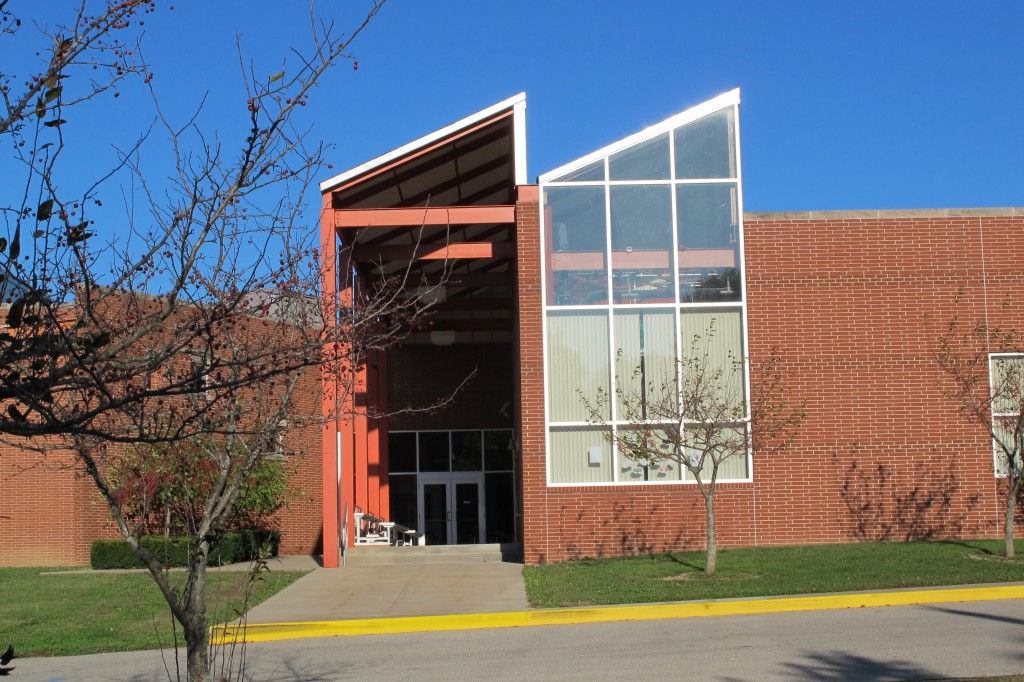
Left side entryway (from the sidewalk to the right was part of the 2002 addition)
(photo by Ricky Berkey)
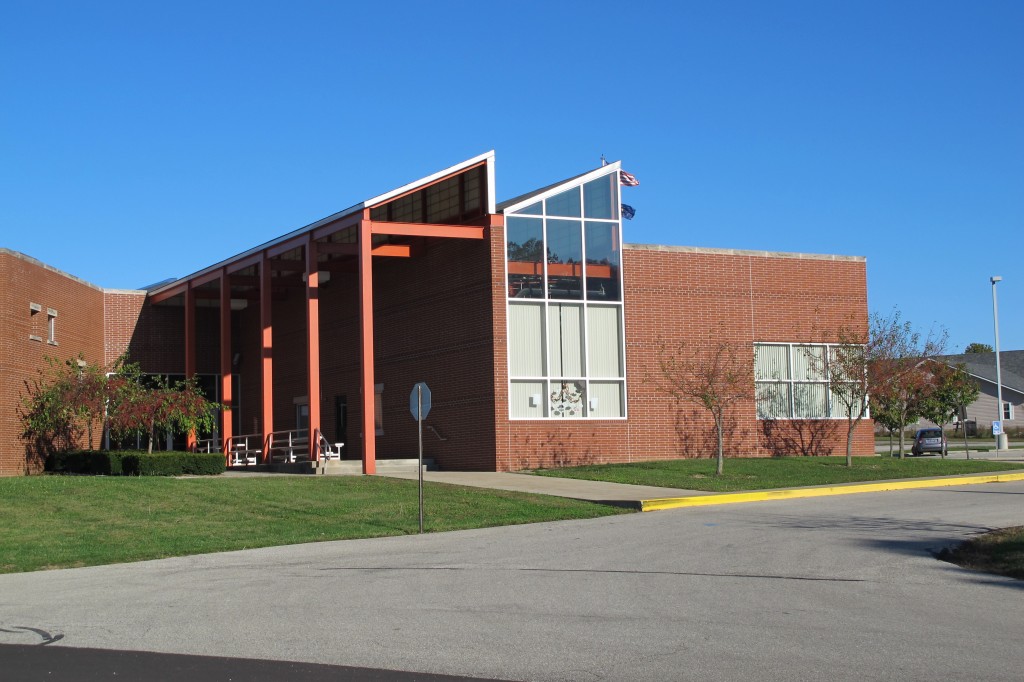
Left side of building (from the sidewalk to the right was part of the 2002 addition)
(photo by Ricky Berkey)
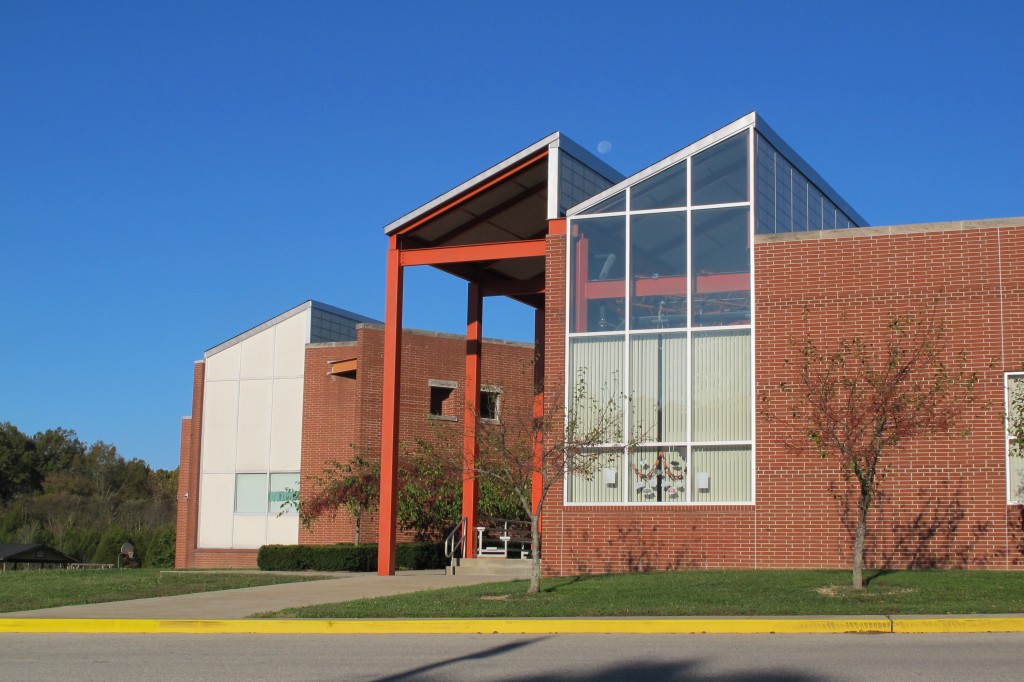
Left side of building (from the sidewalk to the right was part of the 2002 addition)
(photo by Ricky Berkey)
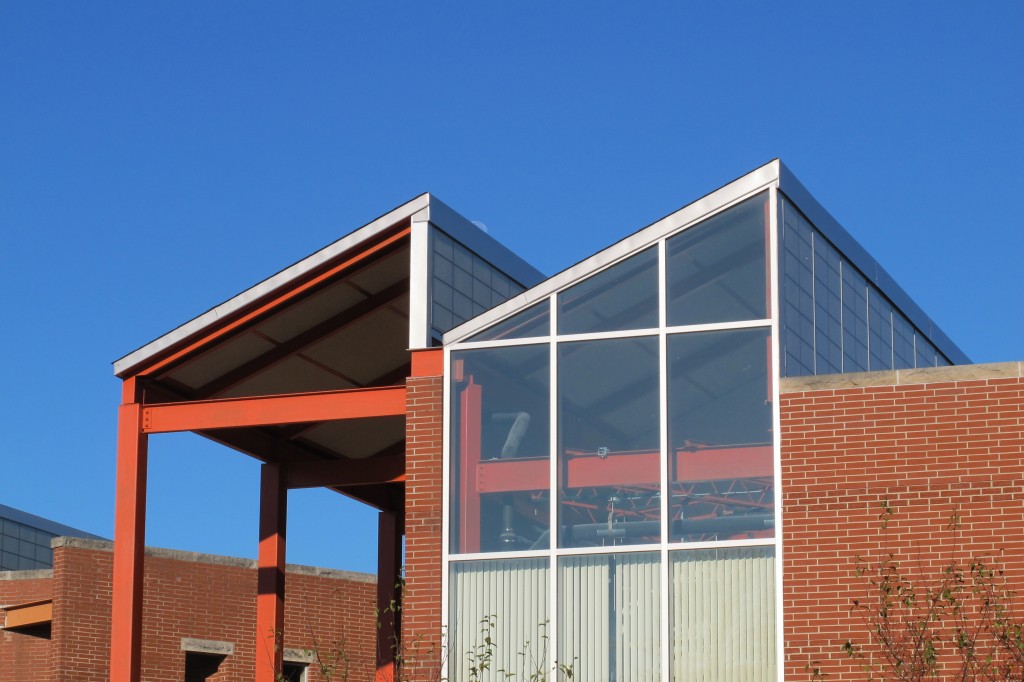
Upper view of left side (part of the 2002 aaddition)
(photo by Ricky Berkey)
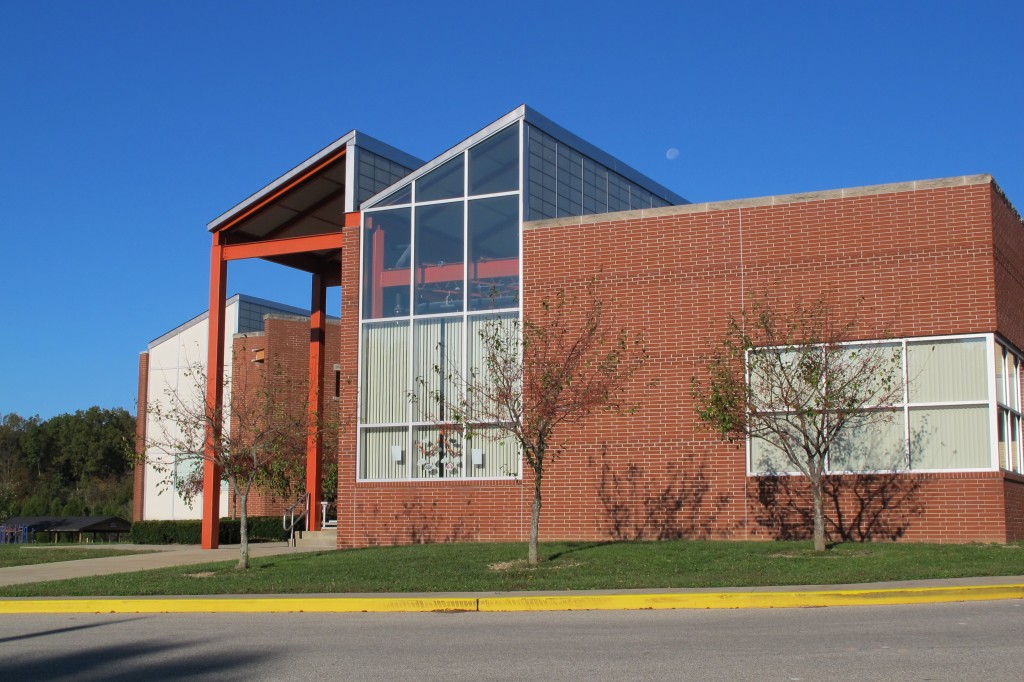
Left side of the building (from the sidewalk to the right was part of the 2002 addition)
(photo by Ricky Berkey)
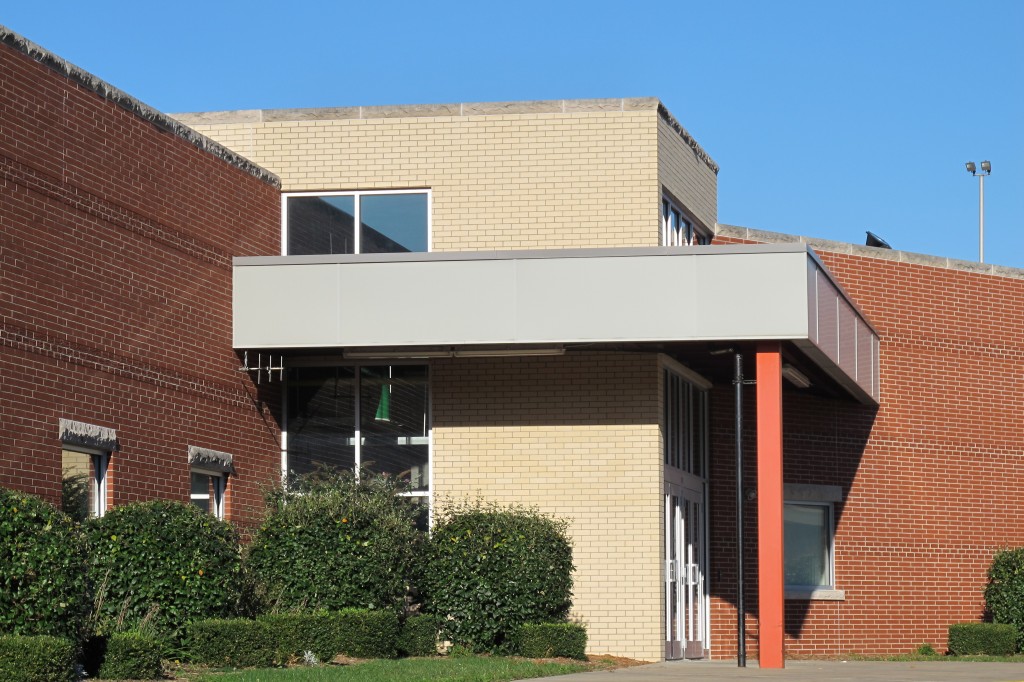
Front side of school from the left (part of the 2002 addition)
(photo by Ricky Berkey)
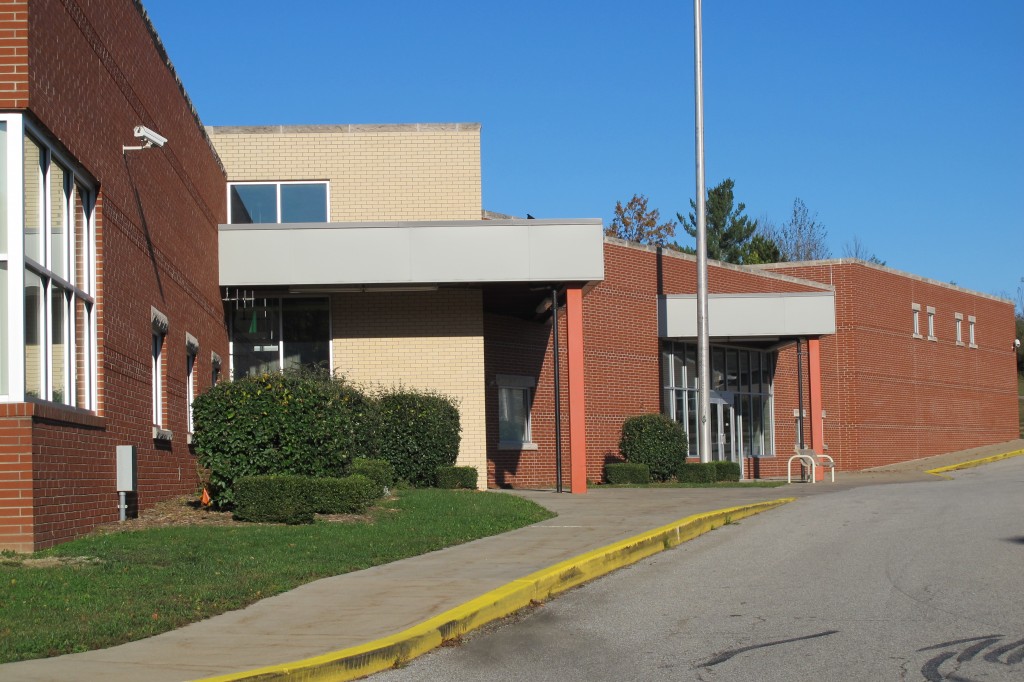
Front side of the school from the left (part of the 2002 addition)
(photo by Ricky Berkey)
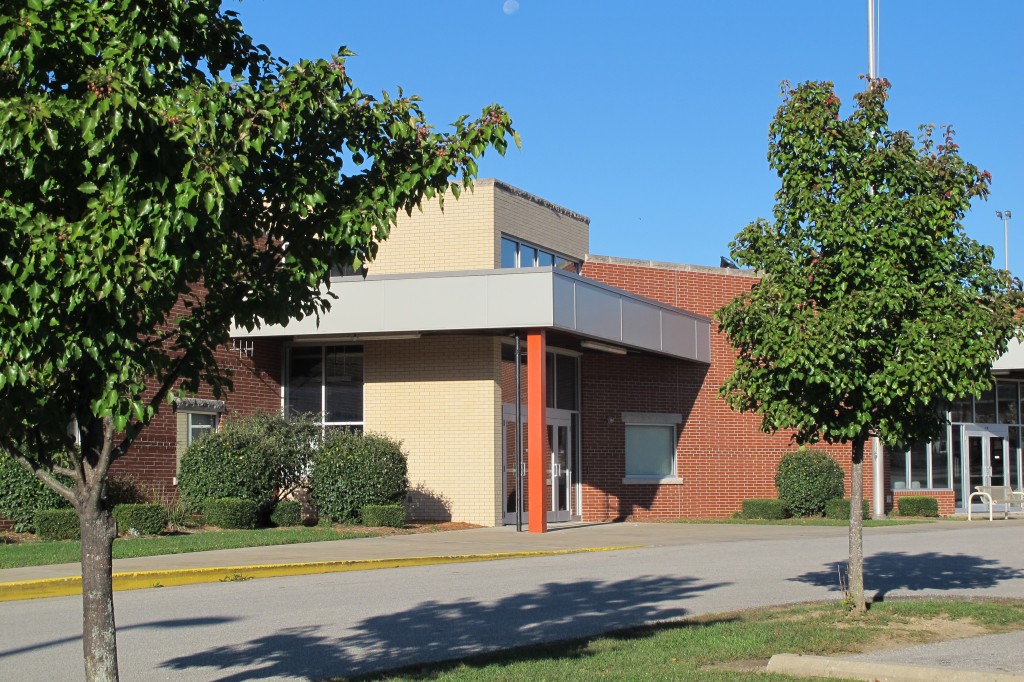
Front side of the school from the left (part of the 2002 addition)
(photo by Ricky Berkey)
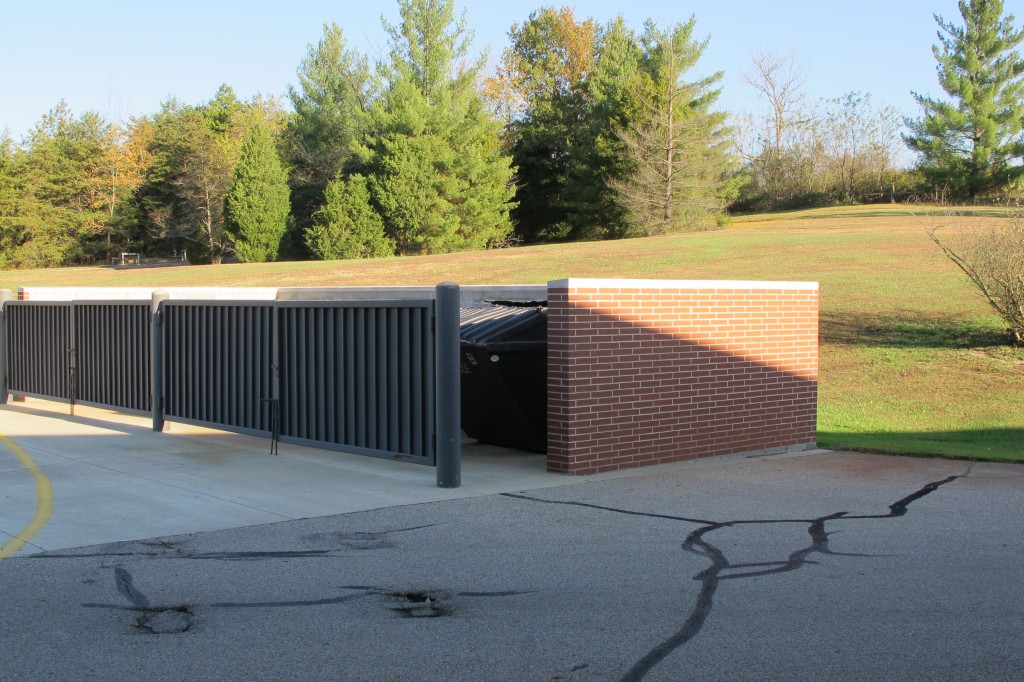
Nice enclosure for the trash collection point
(photo by Ricky Berkey)
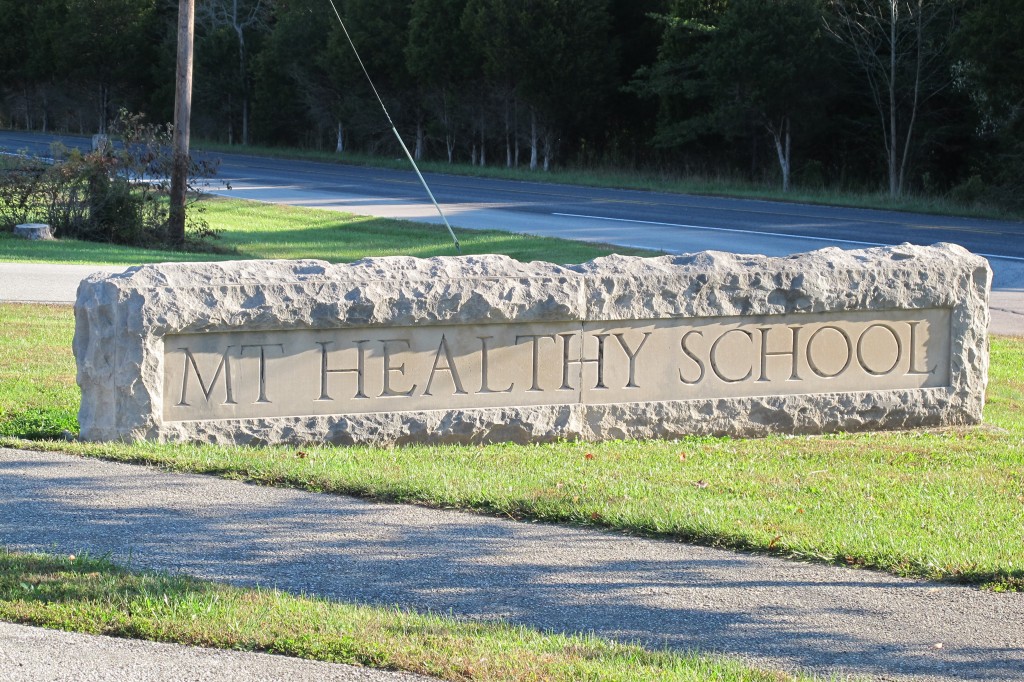
School sign in front replicates material from the window sills and lintels
(photo by Ricky Berkey)
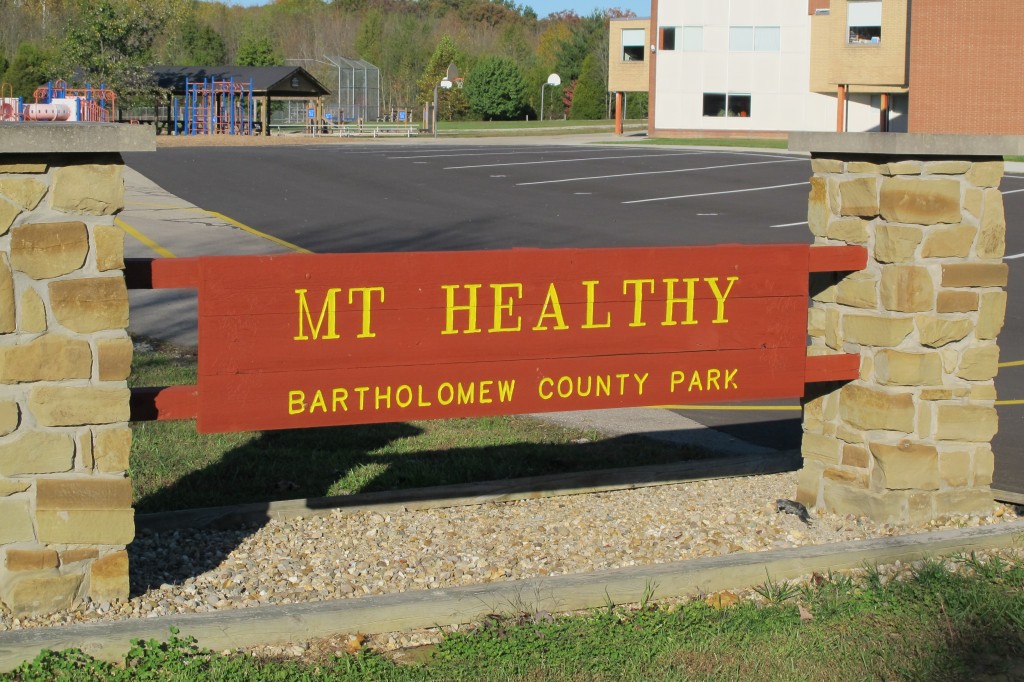
A county park dedicated in 1996 shares space with the school grounds
(photo by Ricky Berkey)
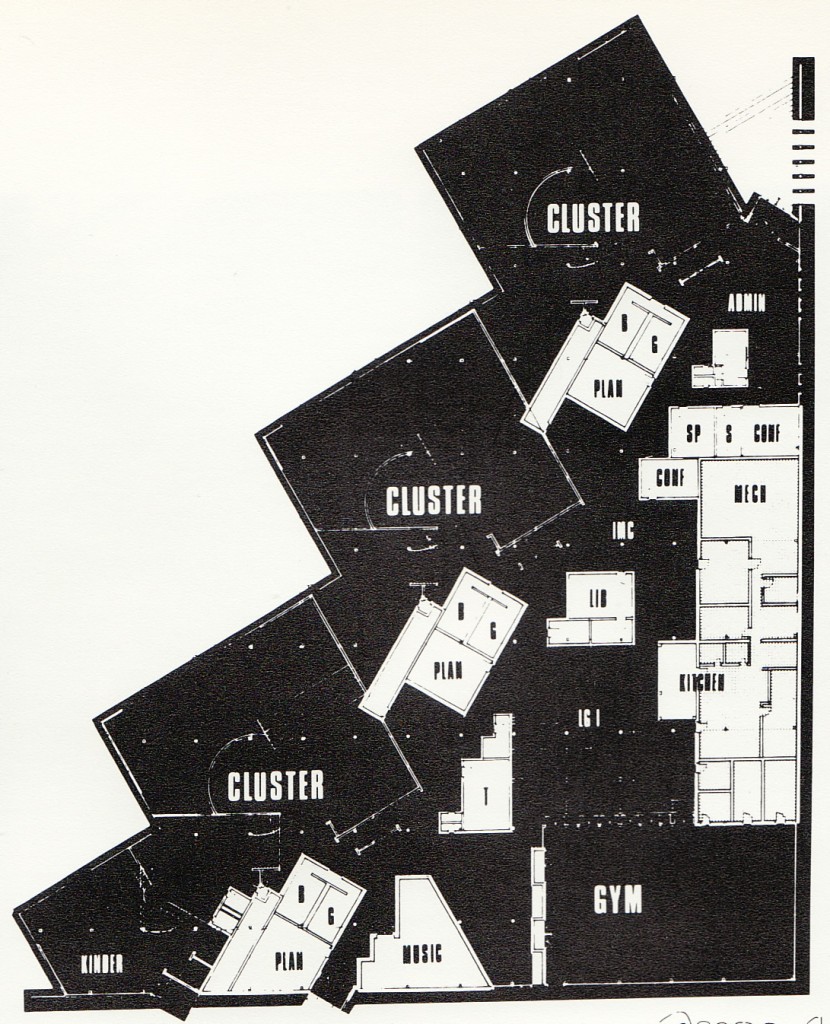 Original floor plan
Original floor plan
(photo used pending permission)
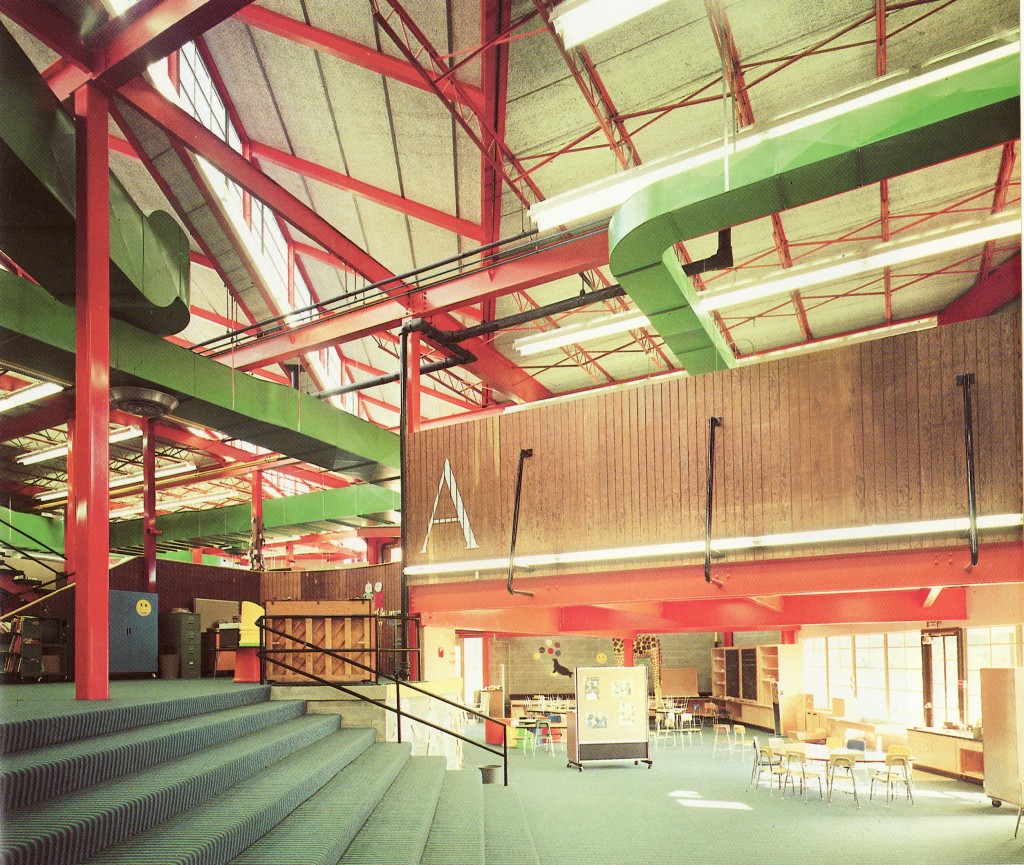 Interior picture from the early 70’s
Interior picture from the early 70’s(photo used pending permission)
The Architects
 Hardy Holzman Pfieffer Associates (HHPA)
Hardy Holzman Pfieffer Associates (HHPA)
Hardy Holzman Pfeiffer Associates (HHPA) was an internationally recognized architectural, planning and interior design firm formed in 1967 by Hugh Hardy, Malcolm Holzman, and Norman Pfeiffer. HHPA was known for using a wider range of materials and architectural styles than their predecessors in the modernist movement. They designed buildings based on their symbolic interpretation of America using industrial prefab components and images of highway culture and pop art including signs, neon and lights. They utilized different styles like a collage colliding forms and superimposing ideas. They used shifted grids and diagonals to break free from the simple rectangular forms of the international style. They strived to produce a more informal, playful and humanistic style of architecture. They are especially known for their design of public buildings. Hardy Holzman Pfieffer maintained ofices in New York and Los Angeles.
Among the honors won by the firm were the Arnold W. Brunner Prize in Architecture awarded by the National Institute of Arts and Letters in 1974 and the AIA Firm Award from the American Institute of Architects in 1981. Their building designs have won numerous awards including the AIA (American Institute of Architects) Honor Award in 1976 for the COHA medical medical building in Columbus, Indiana.
HPFA disbanded in 2004 with the founding partners separating into 3 smaller independent firms: H3 Hardy Collaboration, Holzman Moss Architecture and Pfeiffer Partners.
 Hugh Hardy
Hugh Hardy
- Born in Majorca, Spain in 1932
- Princeton University (BA in Architecture)
- Princeton University (Masters in Fine Arts)
Hugh Hardy was born in Majorca, Spain in 1932 of American parents. Hardy graduated from Princeton University with a Bachelor of Architecture and with a Master of Fine Arts. After college he served a stint with the Navy Engineering Corp. He then worked as the architectural assistant to set designer Jo Mielziner in New York. He founded his own firm in 1962 as Hugh Hardy & Associates. In 1967, he joined with Malcolm Holzman and Norman Pfieffer to form Hardy Holzman Pfieffer Associates (HHPA). In 2004 he split from his longtime partners to form H3 Hardy Collaboration Architecture.
Hardy remains a leading architect best known for his work designing public spaces, theaters, performing arts venues and cultural facilities. He is a Fellow of the American Institute of Architects (AIA) and a member of the American Academy of Arts and Letters. Among honors he has received during his career are the Placemark Award from the Design History Foundation in 2001 and the President’s Award from the New York Chapter of the AIA in 2002. In 2010 he received the Architectural League of New York’s President’s Medal. He has also won the General Services Administration (GSA) Commissioner’s Award for Excellence in Public Architecture.
Hugh Hardy is married to Italian architect Tiziana Hardy and has two children, Sebastian and Penelope.
 Malcolm Holzman
Malcolm Holzman
- Born in Newark, New Jersey in 1940
- Pratt Institute (BA in Architecture)(1963)
Malcolm Holzman was born in Newark, New Jersey in 1940. He received a Bachelor of Architecture from Pratt Institute in 1963. He was one of the co-founders of Hardy Holzman Pfieffer Architects (HHPA) in 1967 with Hugh Hardy and Norman Pfieffer. After the firm disbanded in 2004 he formed Holzman Moss Bottino Architecture (HMBA) in NYC with partner Douglas Moss.
Holzman has designed many important civic and academic structures throughout the United States, especially libraries, museums and performing arts venues. He is known for his pioneering work with Hardy Holzman Pfieffer using creative materials and bold use of colors and textures utilizing rotated grids, diagonals and eclectic sensibilities. He was an early advocate for adaptive reuse of older buildings at a time when his contemporaries were strictly adhering to the tenets of modernism. He was also an early advocate of using green building and sustainable practices to rehabilitate older buildings.
He has held both the Saarinen and Davenport Visiting Professorships at Yale University. He has lectured and held guest professorships at a number of other universities. Holzman is a member of the Interior Design Hall of Fame, the Municipal Art Society and the Architectural League of New York. He has served as a trustee of the Amon Carter Museum and the Pratt Institute. He is a Fellow of the AIA (American Institute of Architects). Holzman has won numerous design awards for his body of work.
 Norman Pfeiffer
Norman Pfeiffer
- Born in Seattle, Washington in 1940
- University of Washington (BA in Architecture)(1964)
- Columbia University – NYC (Masters in Architecture)(1965)
Norman Pfeiffer was born in Seattle in 1940 and received degrees in architecture from the University of Washington in 1964 and Columbia University in 1965. Norman Pfieffer was one of the co-founders of Hardy Holzman Pfieffer Architects (HHPA) in 1967 with Hugh Hardy and Malcolm Holzman. He established the Los Angeles office of HHPA in 1986. In 2004 Hardy Holzman Pfeiffer Associates was dissolved with Norman Pfeiffer taking over the Los Angeles office of HHPA forming Pfeiffer Partners Architects Inc.
His design portfolio includes numerous public buildings and cultural spaces as well as historic renovations and additions. In 1989 he was appointed to the Architectural Commission of the University of Washington. He has served as Visiting Professor of Architectural Design at the University of California at Los Angeles (UCLA). He is a Fellow of the AIA (American Institute of Architects).
Selected Hardy Holzman Pfeiffer Projects
American Film Institute Theater and HQ – Washington D.C. (1973)
Artpark – Lewiston, New York (1974)
Best Products Headquarters – Richmond, Virginia (1979)
Brooklyn Academy of Music Majestic Theater renovation
Brooklyn Children’s Museum – Brooklyn, New York (1977)
Cleveland Public Library (Louis Stokes Wing and garden)
Columbia Public Library
Cooper-Hewitt Museum – NYC (1976)
Cummins Occupational Health Association (COHA) – Columbus, Indiana (1973)
David Saul Smith Union at Bowdoin College
Dillingham Hall at Punahou
Fireman’s Training Center – NYC (1975)
Los Angeles County Museum of Art
Mahaney Center for the Arts and McCullough Student Center at Middlebury College
Mt. Adams Condominiums – Cincinnati, Ohio
Mt. Healthy Elementary School – Columbus, Indiana (1972)
Murchison Performing Arts Center at the University of North Texas
Ohio Exposition and Arts Pavilion – Columbus, Ohio
Orchestra Hall – Minneapolis, Minnesota (1974)
Playhouse in the Park – Cincinnati, Ohio (1963)
Radio City Music Hall renovation
The Salisbury School – Salisbury, Maryland (1972)
San Angelo Museum of Fine Arts
St. Louis Art Museum – St. Louis, Missouri (1977)
Taylor Theater – Lockport, New York (1969)
Virginia Museum of Fine Arts
 Nolan Bingham
Nolan Bingham
- Born in Columbus, Indiana on September 20th, 1946
- Ball State University – Muncie, Indiana (BA in Architecture)
- Ball State University – Muncie, Indiana (BS in Science of Environmental Design
Nolan G. Bingham was born and raised in Columbus, Indiana. After military service and higher education he chose to remain in Columbus as a practicing architect. He is the principal at the Paris Bingham Partnership, a Columbus architecture firm. Along with former partner James K. Paris (retired), the firm has been working in central Indiana for more than 30 years. His Columbus designs include the Ivy Tech State College facility, the City of Columbus Animal Shelter, the addition to the First Christian Church, the addition to the Mt. Healthy Elementary School, renovation of the SIHO Office Building and the Jackson County Bank Branch at Westhill. He served as consultant to Gwathmey, Siegel & Associates architectural firm during the Pence Place Apartments construction and was the local contact and consultant for Thompson and Rose Associates during the construction for the Bartholomew County Veterans Memorial. He is a Vietnam veteran.
Selected Nolan Bingham Projects
1980: IVY Tech – Columbus, Indiana
1981: Orinoco Firehouse Remodel for ARVIN – Columbus, Indiana
1992: Columbus Animal Shelter – Columbus, Indiana
1992: SIHO Office Building – Columbus, Indiana
1980: Fire Station #1 Addition (interiors) – Columbus, Indiana
2002: First Christian Church – Columbus, Indiana
2002: Mt. Healthy School Addition – Columbus, Indiana
2006: Jackson County Bank (West Hill Branch)
Links/References
H3 Hardy Collaboration Architecture: Hugh Hardy’s spinoff firm from Hardy Holzman Pfieffer
Pfieffer Partners Architects:Norman Pfieffers spinoff firm from Hardy Holzman Pfieffer
Holzman Moss Bottino Architects: Malcom Holzman’s spinoff firm from Hardy Holzman Pfieffer
City of Columbus: official City of Columbus website
Columbus Indiana Architectural Archives
Columbus Indiana Architecture Digital Archives: A small portion of the Columbus Indiana Architectural Archives available online from the IUPUI digital library
3D Models of Columbus Architecture Executed in Google SketchUp:
The Republic Newspaper – Columbus, Indiana newspaper
Bartholomew County Public Library
Historic Columbus Website – David Sechrest’s tribute to Columbus History
Historic Columbus Message Board – a companion interactive forum to the David Sechrest historical website
Bartholomew County Historical Society
 Click HERE for a Calendar of Upcoming Events in the Columbus Area.
Click HERE for a Calendar of Upcoming Events in the Columbus Area.
Click HERE for information about Tours of Columbus Architecture and Design including the Miller House.
 Ricky Berkey
Ricky Berkey
Email me: rickyberkey@gmail.com
